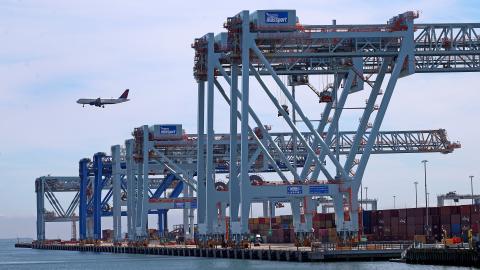Last week, Massachusetts Maritime welcomed the Patriot State, the second vessel in the National Security Multi-Mission Vessel program. While this event may not dominate headlines, it carries profound implications for our nation’s economic prosperity and national security.
The United States has long been a maritime nation. Ports such as Boston, Salem, Nantucket and Marblehead, Massachusetts, have been centers of trade, innovation and exploration for generations.
From raw materials and finished products to agricultural goods and manufactured items, the majority of our nation’s commerce relies on maritime transportation. At a time when roughly 90% of international trade is carried by sea, the U.S. Merchant Marine is critical to ensuring that America remains a key player in the world economy.
Yet the contributions of merchant mariners — the skilled professionals behind our commercial and logistic fleets — often go unrecognized, and the challenges they face are too often overlooked.
We are facing the most severe shortage of merchant mariners since before World War II. Recent reports indicate that the Navy is considering laying up 17 logistic ships due to a lack of qualified crew members. There is also a deficit of nearly 1,839 mariners needed to staff merchant ships vital for military support during conflicts.
This shortage isn’t just a number; it is an urgent vulnerability threatening our economic stability and national security.
That is why the NSMV program and the Patriot State are so important. The Patriot State is more than just a ship; it’s a state-of-the-art training platform equipped with the cutting-edge technological systems found in today’s commercial fleets. It will ensure that Merchant Marine Academy cadets are fully prepared to meet the demands of modern maritime operations and effectively and safely navigate major oceangoing vessels upon graduation.
The journey to this point wasn’t straightforward. For years, maritime academies were saddled with a hodgepodge fleet of aging, obsolete and potentially unsafe vessels. This was a worsening problem that leaders in Washington had ignored for far too long.
That is why I quickly addressed it when I was appointed secretary of transportation in 2017. The Department of Transportation is allotted a discretionary sum of $300 million to allocate at the secretary’s discretion among DOT’s agencies and departments
As one can imagine, every corner of the DOT community was clamoring for a portion of the funds. But the aging fleet of training ships was such a pressing issue that I allocated the full pot toward creating a state-of-the-art training ship.
Furthermore, we adopted innovative procurement strategies — such as fixed-price contracts with private shipbuilders — to ensure the program avoided the typical pitfalls of government projects like budget overruns and delays.
Thankfully, it worked. Not only did the program save taxpayer dollars, it also set an example for American government shipbuilding. It inspired Congress to appropriate funding for four sister ships for maritime academies in New York, Maine, Texas and California. I am grateful to Sen. Susan Collins for shepherding this effort.
The Patriot State was constructed with American steel and built by skilled workers in American shipyards. It is powered by American-made engines. It embodies a resurgence of American manufacturing and showcases what can be achieved when government and industry collaborate effectively. This model promotes fiscal responsibility and could be replicated across various government initiatives.
Investing in the training of merchant mariners is an investment in our nation’s future. These professionals are essential for sustaining our economy, supporting our military, fostering international trade on U.S. flagships and responding to humanitarian crises.
In a world marked by geopolitical tensions and unpredictable natural disasters, their role is critical.
At a time of political polarization, I hope we can come together as a nation to extend our heartfelt gratitude to the maritime academies who train their students, the Maritime Administration, cadets who will train aboard this vessel, the mariners who will benefit from its advanced technology and the shipyard workers who brought it to life.
This ship isn’t just charting a course for its cadets; it is leading us through the 21st century and ensuring the legacy of America’s maritime excellence continues for generations to come.
Enjoyed this article? Subscribe to Hudson’s newsletters to stay up to date with our latest content.















